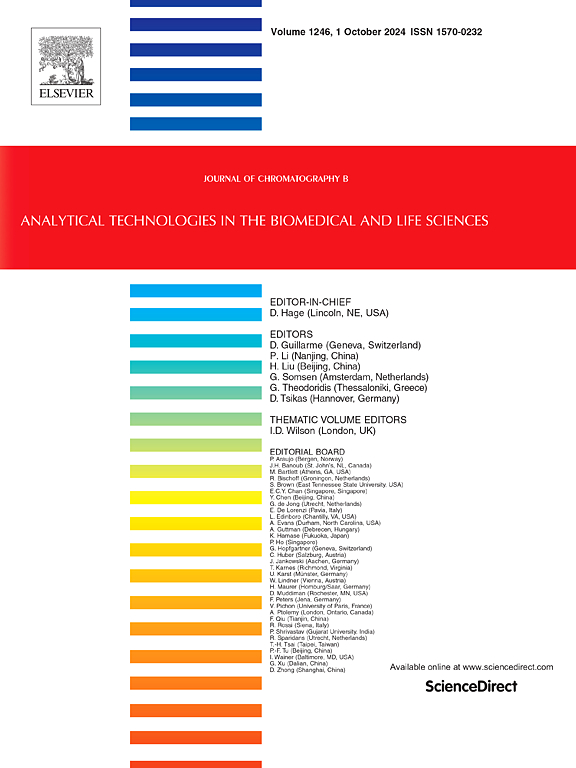Rapid screening of cefotaxime resistance in Escherichia coli isolates by liquid chromatography with absorbance detection.
IF 2.8
3区 医学
Q2 BIOCHEMICAL RESEARCH METHODS
引用次数: 0
Abstract
The clinical outcome of bacterial infection relies on proper and timely diagnosis of antibiotic susceptibility. We demonstrate that liquid chromatography (LC) with diode-array absorbance detection (DAD) accurately diagnoses antimicrobial resistance by measuring cefotaxime recovery following incubation with bacterial isolates either positive or negative for the cefotaximase (CTX-M) family of serine-β-lactamases. Reversed phase, high-performance liquid chromatography with absorbance detection was employed for cefotaxime analysis. A total of 43 blaCTX-M-producing and 5 blaCTX-M-negative Escherichia coli isolates were incubated with 0.5 mg/mL of cefotaxime at 37 °C for 1 and 2 h. Remarkably, after 2 h of incubation, the median ± median absolute deviation percentage of cefotaxime recovery was zero (0 %) for blaCTX-M producing and cefotaxime-resistant E. coli isolates compared to the cefotaxime recovery in blaCTX-M negative (61 ± 5.38 %) and cefotaxime-susceptible (70.68 ± 6.25 %) E. coli isolates. This result allows facile sorting of organism resistance status after only 1–2 h with near-perfect performance. The diagnostic sensitivity (Se) and specificity (Sp) of the chromatographic approach were comparable to widely used phenotypic (Epsilometer test, E-test) and genotypic assays (Whole Genome Sequencing, WGS), but chromatography reduces diagnostic time by >10-fold. Additionally, the optical absorption measurement is fully compatible with microfluidic platforms, suggesting the development of low-cost, high-throughput sensors based on this measurement principle is possible. We conclude LC-DAD is suitable and reliable to determine the cefotaxime resistance status of E. coli isolates with a turn-around time of only 1–2 h.
细菌感染的临床疗效取决于正确及时的抗生素敏感性诊断。通过测定头孢他啶与丝氨酸-β-内酰胺酶家族中头孢他啶酶(CTX-M)阳性或阴性细菌分离物培养后的回收率,我们证明了采用二极管阵列吸光度检测(DAD)的液相色谱法可准确诊断抗菌药耐药性。头孢他啶分析采用了反相高效液相色谱法和吸光度检测法。将 43 株产 blaCTX-M 的大肠埃希菌和 5 株 blaCTX-M 阴性的大肠埃希菌分离物与 0.5 mg/mL 的头孢他啶在 37 ℃ 下培养 1 小时和 2 小时。值得注意的是,培养 2 小时后,与 blaCTX-M 阴性(61 ± 5.38 %)和头孢他啶敏感(70.68 ± 6.25 %)大肠埃希菌分离物的头孢他啶回收率相比,产生 blaCTX-M 和头孢他啶抗性的大肠埃希菌分离物的头孢他啶回收率中位数±绝对偏差百分比为零(0 %)。这一结果可在 1-2 小时后对生物体的耐药性状态进行简单分类,且性能接近完美。色谱法的诊断灵敏度(Se)和特异性(Sp)与广泛使用的表型检测法(Epsilometer test,E-test)和基因型检测法(Whole Genome Sequencing,WGS)相当,但色谱法将诊断时间缩短了 10 倍。此外,光学吸收测量与微流控平台完全兼容,这表明基于这种测量原理开发低成本、高通量传感器是可能的。我们得出结论:LC-DAD 适用于测定大肠杆菌分离物的头孢他啶耐药性状态,且结果可靠,周转时间仅为 1-2 小时。
本文章由计算机程序翻译,如有差异,请以英文原文为准。
求助全文
约1分钟内获得全文
求助全文
来源期刊

Journal of Chromatography B
医学-分析化学
CiteScore
5.60
自引率
3.30%
发文量
306
审稿时长
44 days
期刊介绍:
The Journal of Chromatography B publishes papers on developments in separation science relevant to biology and biomedical research including both fundamental advances and applications. Analytical techniques which may be considered include the various facets of chromatography, electrophoresis and related methods, affinity and immunoaffinity-based methodologies, hyphenated and other multi-dimensional techniques, and microanalytical approaches. The journal also considers articles reporting developments in sample preparation, detection techniques including mass spectrometry, and data handling and analysis.
Developments related to preparative separations for the isolation and purification of components of biological systems may be published, including chromatographic and electrophoretic methods, affinity separations, field flow fractionation and other preparative approaches.
Applications to the analysis of biological systems and samples will be considered when the analytical science contains a significant element of novelty, e.g. a new approach to the separation of a compound, novel combination of analytical techniques, or significantly improved analytical performance.
 求助内容:
求助内容: 应助结果提醒方式:
应助结果提醒方式:


